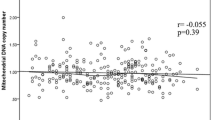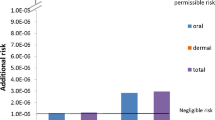Abstract
Background
Artificial sports fields are increasingly being used for sports. Recycled rubber from automotive and truck scrap rubber tires are used as an infill material for football grounds. There are concerns that football players may be at risk due to exposure from released compounds from rubber infill. Compounds from crumb infill may be inhaled and dermal exposure may occur. A study was performed to assess the exposure of football players to polycyclic aromatic hydrocarbons due to sporting on synthetic ground with rubber crumb infill.
Methods
In this study, football players were trained and had a match on the artificial turf pitch during 2.5 h. They had an intensive skin contact with rubber infill. All urine of seven nonsmoking football players was collected over a 3-day period, the day before sporting, the day of sporting and the day after sporting. Urine samples were analyzed for 1-hydroxypyrene. Confounding exposure from environmental sources and diet was controlled for.
Results
The individual increase of the amount of excretion over time was used as a measure to assess the uptake of PAH. It appeared that the baseline of excreted 1-hydroxypyrene in 4 of 7 volunteers was sufficient stable and that 1 volunteer out of 4 showed after the 2.5-h period of training and match on the playground an increase in hydroxypyrene in urine. However, concomitant dietary uptake of PAH by this volunteer was observed.
Conclusions
This study provides evidence that uptake of PAH by football players active on artificial grounds with rubber crumb infill is minimal. If there is any exposure, than the uptake is very limited and within the range of uptake of PAH from environmental sources and/or diet.

Similar content being viewed by others
References
ACGIH (2005) BEI-documentation of PAH. ACGIH BEI-Committee, Cincinatti
Birkholz DA, Beltion KL, Guidotti TL (2003) Toxicological evaluation for the hazard assessment of tire crumb for use in public playgrounds. Air Waste Management 53:9003–9907
Bouchard M, Viau C (1999) Urinary 1-hydroxypyrene as a biomarker of exposure to polycyclic aromatic hydrocarbons: Biological monitoring strategies and methodology for determining biological exposure indices for various work environments. BIOMARKERS 4:159–187
Buchet JP, Gennart JP, Mercado-Calderon F, Delavignette JP, Cupers L, Lauwerys R (1992) Evaluation of exposure to polycyclic aromatic hydrocarbons in a coke production and a graphite electrode manufacturing plant: assessment of urinary excretion of 1-hydroxypyrene as a biological indicator of exposure. Br J Ind Med 49:761–768
Buckley TJ, Lioy PJ (1992) An examination of the time course from human dietary exposure to polycyclic aromatic hydrocarbons to urinary elimination of 1-hydroxypyrene. Br J Ind Med 49:113–124
Dor F, Dab W, Empereur-Bissonnet P, Zmirou D (1999) Validity of biomarkers in environmental health studies: the case of PAHs and benzene. Crit Reviews Toxicology 29:129–168
Elovaara E, Heikkilä P, Pyy L, Mutanen P, Riihimäki V (1995) Significance of dermal and respiratory uptake in creosote workers: exposure to polycyclic aromatic hydrocarbons and urinary excretion of 1-hydroxypyrene. Occup Environ Med 52:196–203
FEA (Federal Environmental Agency of Germany) (2005) 1-Hydroypyrene in urine. Reference value. Bundesgesundheidbl 48:1194–1206
Gardiner K, Hale KA, Calvert IA, Rice C, Harrington JM (1992) The suitability of the urinary metabolite 1-hydroxypyrene as an index of polynuclear aromatic hydrocarbon bioavailability from workers exposed to carbon black. Ann Occup Hyg 36:681–688
Hansen AM, Mathiesen L, Pedersen M, Knudsen LE (2008) Urinary 1-hydroxypyrene (1-HP) in environmental and occupational studies - A review. Int J Hyg Environ Health 211:471–503
Hofstra U (2007) Environmental and health risks of rubber infill rubber crumb from car tyres as infill on artificial turf. INTRON. Report A833860/R20060318. Sittard-NL
Jongeneelen FJ, Anzion RB, Leijdekkers CM, Bos RP, Henderson PT (1985) 1-hydroxypyrene in human urine after exposure to coal tar and a coal tar derived product. Int Arch Occup Environ Health 57:47–55
Jongeneelen FJ, Anzion RBM, Henderson PT (1987) Determination of hydroxylated metabolites of polycyclic aromatic hydrocarbons in urine. J Chromatography 413:227–232
Peters S, Talaska G, Jönsson BA, Kromhout H, Vermeulen R (2008) Polycyclic aromatic hydrocarbon exposure, urinary mutagenicity, and DNA adducts in rubber manufacturing workers. Cancer Epidemiol Biomarkers Prev 17:1452–1459
Schoket B, Hewer A, Grover PL, Phillips DH (1988) Covalent binding of components of coal-tar, creosote and bitumen to the DNA of the skin and lungs of mice following topical application. Carcinogenesis 9:1253–1258
Tolos WP, Shaw PB, Lowry LK, MacKenzie BA, Deng JF, Markel HL (1990) 1-Pyrenol: a biomarker for occupational exposure to polycyclic aromatic hydrocarbons. Appl Occup Environ Hyg 5:303–309
Tsai PJ, Shieh HY, Lee WJ, Chen HL, Shih TS (2002) Urinary 1-hydroxypyrene as a biomarker of internal dose of polycyclic aromatic hydrocarbons in carbon black workers. Ann Occup Hyg 46:229–235
Unwin J, Cocker J, Scobbie E, Chambers H (2006) An assessment of occupational exposure to polycyclic aromatic hydrocarbons in the UK. Ann Occup Hyg 50:395–403
Van Rooij JG, Bodelier-Bade MM, De Looff AJ, Dijkmans AP, Jongeneelen FJ (1992) Dermal exposure to polycyclic aromatic hydrocarbons among primary aluminium workers. Med Lav 83:519–529
Van Rooij JG, De Roos JH, Bodelier-Bade MM, Jongeneelen FJ (1993) Absorption of polycyclic aromatic hydrocarbons through human skin: differences between anatomical sites and individuals. J Toxicol Environ Health 38:355–368
Van Rooij JG, Veeger MM, Bodelier-Bade MM, Scheepers PT, Jongeneelen FJ (1994) Smoking and dietary intake of polycyclic aromatic hydrocarbons as sources of interindividual variability in the baseline excretion of 1-hydroxypyrene in urine. Int Arch Occup Environ Health 66:55–65
Viau C, Carrier G, Vyskocil A, Dodd C (1995) Urinary excretion kinetics of 1-hydroxypyrene in volunteers exposed to pyrene by the oral and dermal route. Sci Total Environ 163(1–3):179–186
WHO (1996) Biological monitoring of chemical exposure in the workplace. Vol 2. Ch 4.1 Polycyclic aromatic hydrocarbons: 1-hydroxypyrene in urine. pp 190–201. WHO/HPR/OCH 96.2 Geneva, 1996 ISBN 951-802-167-8
Zhang JJ, Han IK, Zhang L, Crain W (2008) Hazardous chemicals in synthetic turf materials and their bioaccessibility in digestive fluids. J Expo Sci Environ Epidemiol. 18:600–607
Acknowledgments
Contribution of the following persons and organizations is gratefully acknowledged: The football club SV Juliana’31 in Malden, the Netherlands, especially the players of football team A6 and Henry Jansen (Technical coordinator). Members of the project monitoring group with representatives from Ministry of VROM, Grontmij, INTRON, VVCS, DSM, Ten Cate Thiolen, Ministery of VWS, KNVB, Kempeneers Milieumanagement, Arcadis, RecyBem, Syntens, ISA Sport, NOC*NSF, VNG, VACO. Members of the technical committee: A. Boersma (RIVM), B. van Bree and U. Hofstra (INTRON), Frank Kempeneers (Kempeneers Milieumanagement), N. Salzmann (ISA Sport), E. Tjoe Nij (TNO Arbeid) and E. van der Zande (DSM Product Safety). This study is funded by the following organizations in the Netherlands: KNVB, NOC*NSF, WG Materialen, VACO, DSM, RecyBem and Ten Cate.
Author information
Authors and Affiliations
Corresponding author
Rights and permissions
About this article
Cite this article
van Rooij, J.G.M., Jongeneelen, F.J. Hydroxypyrene in urine of football players after playing on artificial sports field with tire crumb infill. Int Arch Occup Environ Health 83, 105–110 (2010). https://doi.org/10.1007/s00420-009-0465-y
Received:
Accepted:
Published:
Issue Date:
DOI: https://doi.org/10.1007/s00420-009-0465-y




